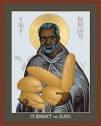
Feast day: 4 April
Benedict was born to Cristoforo and Diana Manasseri, Africans, who were taken as slaves to San Fratello, a small town near Messina in Sicily. They were given Italian names and soon after converted to Christianity. The Italian Il Moro, meaning dark-skinned, has been interpreted as referring to Moorish heritage. Benedict’s parents were granted freedom for their son before his birth, because of their loyal service. Benedict did not attend school and was therefore illiterate. During his youth he worked as a shepherd and gave generously of what he earned to the poor. When he was 21 he was publicly insulted because of his colour. His forbearance at the time was noted by the leader of an independent group of hermits on nearby Mount Pellegrino, who followed the Rule for hermit life drawn up by St Francis of Assisi. Bernard was invited to join the group. He became the cook and at the age of 28 was appointed their leader on the death of Jerome Lanze.
In 1564 Pope Pius IV disbanded independent communities of hermits, ordering them to attach themselves to an established religious order. Benedict became a member of the Franciscan Order of Friars Minor and was assigned to the Friary of St Mary of Jesus, Palermo. He started as a cook, but because of his advancement in the spiritual life he was soon appointed as Master of Novices and later as Guardian of the community, even though he was a lay brother (not a priest) and illiterate.
He helped develop a stricter version of the Franciscan rule; he was widely respected for his deep, intuitive understanding of scripture and theology, and his advice was often sought. He also had a reputation as a healer. Visitors came regularly to see him. As he enjoyed cooking, he returned to the kitchen in his later years. Though the friary was poor and depended on charity, there always seemed to be enough food during his watch.
Benedict predicted the very day and hour of his death. He was 65. It is said that he had a vision of St Ursula before he died.
The entrance to his cell is marked with a plaque inscribed as follows: “This is the cell where St Benedict lived.”
When he died, King Philip III of Spain ordered the construction of a magnificent tomb to house his remains in the friary church (at that time Sicily was ruled by Spain).
Benedict was canonized in 1807 by Pope Pius VII. He was declared patron of African Americans, being remembered for his patience with racial taunts.
St Benedict, pray for us.